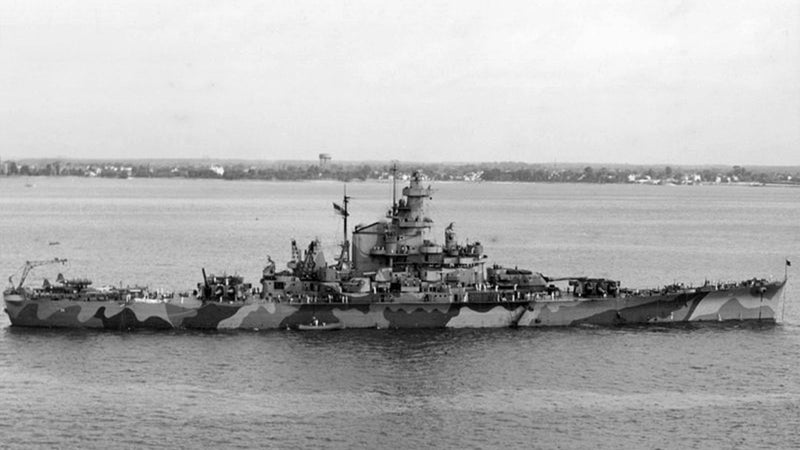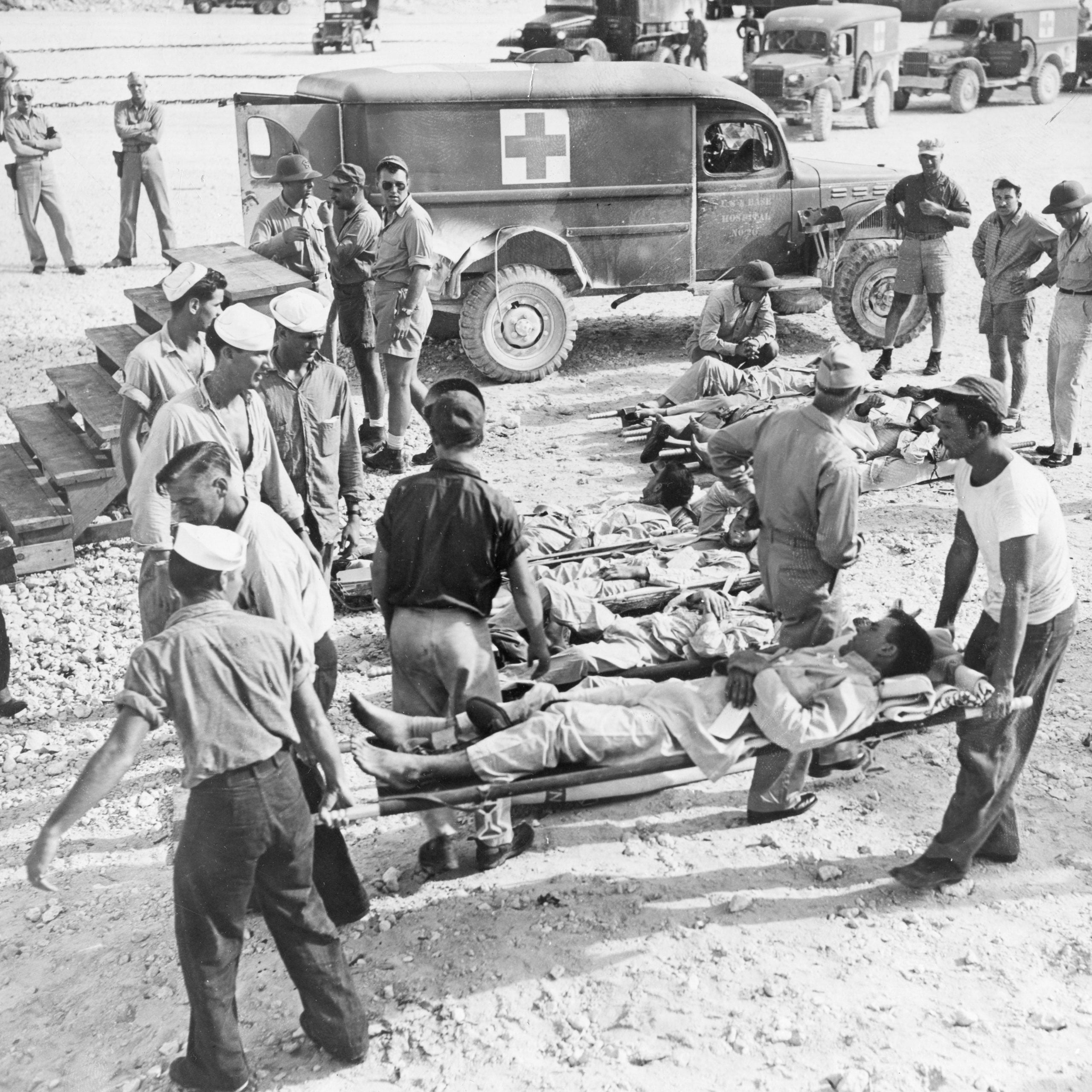The sinking of the USS Indianapolis, at the tail end of World War II, was the worst at-sea disaster in U.S. naval history. Nearly 900 sailors died, an outcome that led to the unfair court-martial and, later, pardon of Captain Charles McVay. The Indianapolis also inspired a in Jaws about one character’s fictional stint on the ship. When a writer first told Steven Spielberg the Indianapolis’ story, the director could hardly believe it. “I remember just saying, ‘Hey, this is a movie!’” he . “‘Somebody someday should do a movie just about the Indianapolis.’�ĝ
Now somebody has.
On November 11, USS Indianapolis: Men of Courage chugged into theaters in a limited release. (It’s also available on demand.) You might remember the movie from earlier this fall, when the internet at its trailer—heavy on Nicholas Cage and sharks. The movie doesn’t disprove that reaction. It’s a cheaply made dud, with Cage channeling his usual barely subdued mania as Captain McVay while the sharks basically jump themselves.
And yet the movie also provides a chance to remember the true story of the USS Indianapolis—a real-life survival tale that’s far superior to the Hollywood version.
The basic facts of the Indianapolis remain powerful and tragic. In the summer of 1945, the ship went on a stealthy solo voyage from San Francisco to Tinian, a small island in the Pacific. The objective was to deliver two key components for the atomic bomb that would ultimately fall on Hiroshima. “For this secret mission,” Cage says in a weary voiceover, “we are in effect a glorified postal service, delivering two packages with no protection.”
The Indianapolis delivered its cargo, of course, ensuring that the bomb would drop. But while the ship was heading to the Philippines, it encountered a Japanese submarine and took two torpedoes to the hull. The American ship sank in just 12 minutes. Of the 1,197 sailors aboard, about 900 escaped. Four days later, a plane spotted the remaining men, but only 317 made it home alive.

Here’s how those men survived. After their ship slid out of sight, the remaining sailors—a few on life rafts and many more clinging to life jackets or floating debris—found themselves bobbing in a dark and eerie quiet. Everything had happened so quickly that most were naked or in their underwear. Fuel oil covered the ocean in every direction.
Once the sun rose, they evaluated their situation. Some discovered cans of Spam and other supplies in the rafts; others located emergency fishing gear and flare pistols. As the sun grew hotter, they began to develop sunburns and skin rashes in addition to their burns from the ship’s fires. Almost everyone was vomiting due to the fuel oil, which had coated their eyes, noses, and mouths.
The sharks came next. At first they seemed curious, unused to humans floating in the ocean, and circled the men at a distance. Many of the men had never seen a shark. “I had seen pictures in a movie,” one sailor remembered in , a terrific oral history of the ship. Now he was seeing them in the flesh, their fins getting nearer and nearer until the sharks slipped beneath the water and passed so close that the men could watch them even through the oily murk. “One of the sailors drifted away from the group,” the sailor continued, “about 25 feet away. While I was watching, his head went under, and I did not see him again. Made one wonder who was next.”
While the men tried to stay in their groups, they had no idea where the sharks would strike. Whenever the men saw a fin, they would cup their hands and smack the water or even hit the shark, hoping to scare it away. Eventually, the sharks focused on the dead sailors drifting among the living. There were more and more casualties to choose from. As the sun set on that first day, the broiling heat turned to a deep and persistent cold. The men’s life jackets grew waterlogged, which left them sitting lower and lower until their chins were just above the water. Even in the dark, they could feel the sharks brush against their legs.
On the second day, many of the men encountered a new enemy: themselves. They were dehydrated from vomiting and delirious from the conditions. Nobody had slept for more than a few minutes at a time because the waves kept jolting them awake. They were hungry. (A few had tried eating the Spam, only to find that the meat drew even more sharks.) Those who gave in to drinking saltwater began to hallucinate. One common vision was that the ship hadn’t completely sunk but was floating a few feet under the ocean—that the swimmers could dive down and find fresh water or cool ice cream. Another man swore he saw an A&W root beer stand hovering up ahead, just out of reach.
Most of the men who chased these hallucinations never came back. The sailors continued to die, but they also continued to live. After four days, an American pilot spotted them—only the first step in a long and precarious rescue.
USS Indianapolis: Men of Courage doesn’t do justice to those four brutal days, in part because it tries to be too many different movies—a war movie about the crew, a disaster movie about the ship, and a courtroom drama about the captain. It should have stuck to being a survival movie, a story of courage, drowning, dehydration, and, yes, sharks.
The shark scenes are probably the best parts of the movie, capturing the terrifying randomness of the attacks. But USS Indianapolis doesn’t show enough of the sailors fighting back—and it certainly doesn’t do enough to illustrate challenges like the oil or the hallucinations. “You ain’t scaring them off,” one sailor tells another who’s swinging at the sharks. “You’re ringing the dinner bell.” In truth, most of the real sailors believed fighting off the sharks kept them alive. But the movie seems more interested in wised-up dialogue than depicting the actual rigors of survival.
USS Indianapolis and the people behind it have their heart in the right place; the movie is dedicated to the survivors and their families. But it strings together far too many clichés: Cage’s inspirational speeches, a moment on the home front where someone enters a Southern mansion and actually quotes Gone with the Wind, a scene in a smoke-filled room where some admirals decide the ship’s fate. “That’s a damn suicide mission,” says one. “If it works, they’re heroes,” says another.
They were heroes. In one of USS Indianapolis’ early scenes, we meet the ship’s chaplain, a man so beloved by his fellow sailors that they throw him a surprise party to celebrate his final tour. It’s the kind of calculated moment that guarantees the chaplain will die, and that’s exactly what happens. But the real USS Indianapolis had a real chaplain. His name was Father Thomas Conway, and he was from Buffalo, New York. After the ship sank, he swam from group to group, encouraging the living and praying over the dead. On the third day, he died of exhaustion. “Father Conway was saying prayers and thrashing the water,” remembered another of the survivors, “when he collapsed in delusion and expired.”


